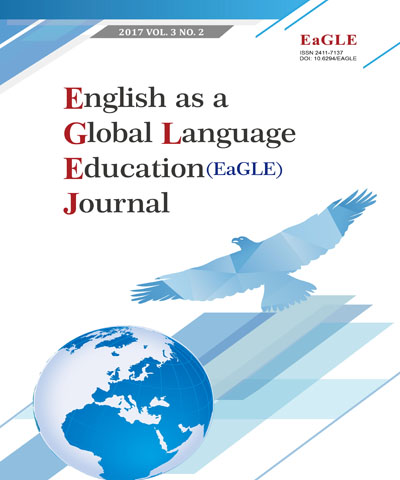
English as a Global Language Education (EaGLE) Journal
國立成功大學外語中心,停刊
選擇卷期
- 期刊
This introduction provides an overview of the keynote speeches presented at the Symposium on Content and Language Integrated Learning for Primary Education held at National Cheng Kung University, Taiwan, in November 2017. Research addressed includes Diane Pecorari's paper titled "Bullseye! From EMI and CLIL to Something Better Still", which weighs Content Language Integrated Learning (CLIL) against English Medium Instruction (EMI), Elisabet Pladevall-Ballester's study of "CLIL in Low Proficiency Primary School Settings: The Role of L1 Use and Focus on Form", which explores content and language integration in Spanish primary schools , Ana Llinares's investigation into "Classroom Interaction in CLIL Primary School Classrooms: Research Insights to Inform Successful Pedagogy", which examines global trends of teaching foreign languages at a young age and integrating language teaching with other academic disciplines (i.e., CLIL), and Erwin Maria Gierlinger's analysis of "The Challenging Interplay of Content, Context, and Community for CLIL Implementations and a Didactic Model to Cope With CLIL's Hybrid Pedagogy", which elucidates the complexity of CLIL in the context of the European Union. The views thus expressed are juxtaposed against new developments in English language education in Taiwan, as seen from the viewpoint of local scholars, educators on the frontline, and government experts engaged in language planning.
- 期刊
Content and Language Integrated Learning (CLIL) programmes are now widespread in primary and secondary education across Europe, and include a range of educational practices with varying aims and policies. CLIL implementation in low proficiency primary school settings in low exposure contexts presents a challenging pedagogical scenario with often higher expectations than actual learning outcomes. Appropriate integration of content and language at the classroom level might well compensate for such low exposure and classroom-based research practices provide the tools to make this integration more effective. This article reviews a study on CLIL implementation in four primary schools in a low exposure context (Catalonia, Spain) and its effects on language gains, L1 use, Foreign Language (FL) motivation and stakeholders' opinions and perceptions. An overview of the results will make the need for integration and research at the classroom level evident, and content and language integration will be explored through two recent projects on the role of L1 use and focus on form strategies in CLIL settings.
- 期刊
Two major new trends in foreign language teaching are gradually being implemented at schools all over the world: the teaching of foreign languages at an early age and the integrated teaching of foreign languages and other academic disciplines (CLIL-Content and Language Integrated Learning). Far from being separate models, these two educational trends are increasingly brought together in some European countries, like Spain. Focusing on the primary school level, this paper addresses two areas that have been recently identified as requiring special attention in CLIL research and pedagogy: the role of content and language integration and classroom interaction as a learning environment. Drawing on systemic-functional, sociocultural and discursive-pragmatic approaches to classroom interaction, the present paper explores the features of classroom discourse that promote content and language integrated learning (Llinares et aI., 2012). These features are illustrated in different studies carried out by the UAMCLIL research group (http://www.uam-cliI.org) in CLIL primary schools, which address the role of the school subject in students' content and language production (Llinares, 2017), the potential of group work to promote students' participation (Llinares & Pastrana, 2013) and the role of assessment for learning to enhance learners' content and language engagement (Pascual & Basse, 2017).
- 期刊
In 2014, a document was issued by the European Commission that investigated improvements in the learning of language. The paper stated that the effectiveness of foreign language education in many member states was problematic and suggested that a renewed focus had to be put on the quality of language teaching. Through a comparative European analysis, CLIL, (content and language integrated learning) evolved as a candidate for making language learning more efficient. While the overall results were very encouraging, the specifics remained vague. Statements such as, "research indicates that teachers' choices of pedagogical and didactic approaches affect the success of CLIL" were reminiscent of a magic potion whose ingredients remained unknown and elusive. This presentation points out how implementing CLIL instruction is contingent on concepts such as content, context, and community and how any implementation of CLIL can be undertaken more systematically by using a model of CLIL called the "CLIL teaching triangle." Taking "languaging" as a guiding concept, this work elaborates how CLIL's fundamental dilemma of how to bridge the cognitive-linguistic content divide can be successfully mediated through carefully orchestrated languaging activities. To achieve this, a model of micro instantiation of CLIL that was tried and carried out in the Austrian context of CLIL teacher education is presented (Cierlinger, 2017).

